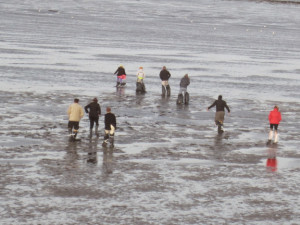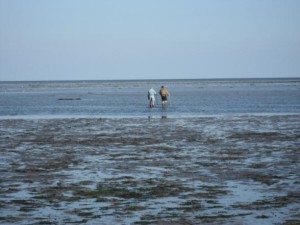

The Darter family and Cor Ellen searching for S/Sgt Eugene F. Darter in the Wadden Sea at low tide.
On a windy and foggy winter’s day, 17-year-old Dutchman Cornelius Ellen was standing on the Texel dike when the wind blew Eugene’s parachute over the Texel Island shore. When my brother splashed down, Cor reported that he was pulled further and further out into the Wadden Sea by a fierce wind that lifted his still connected parachute up like a half-moon out into the sea until he was “Gone With the Wind.” What happened after that is still a big mystery. There are several possibilities.
Did Eugene’s remains wash up on the Texel Island shore? Cor walked along the Texel dike every day for over a year but did not see his remains wash ashore. Even if they had and were found by someone else, the authorities would have been notified and my brother would have been temporarily buried in the War Cemetery on Texel. This was the final resting place for many Allied aircraft crewmen who washed up on the Texel shores from the North Sea and Wadden Sea. A careful examination of a detailed list of remains that washed ashore and were buried on Texel Island (including all Americans originally buried there) did not reveal any likely unknowns after December 16, 1943.
Did Eugene’s remains wash up on the shore of nearby Frisian Islands or on the European side of the Wadden Sea? Many airmen washed up on these shores and they were temporarily buried locally and then reinterred by the American Graves Recovery teams after the war to the American Cemetery at Margraten. Nearly one of every three airmen who died in the air war over Europe is still MIA. Remains of some of these MIAs were recovered (without identification) and became “unknowns” with X-file numbers buried in American military cemeteries. I have examined (causing great sadness) many of the X-files of unknowns in the north Netherlands area and none were perfect fits. There was typically some reason to reject the unknown, however, there were a few possibilities. Further investigation is underway.
Are Eugene’s remains somewhere out in the mysterious Wadden Sea? My children and I have visited Texel every year from 2000 to 2014. We often walk out into the Wadden Sea at low tide, “looking for Eugene.” The Wadden Sea was quite shallow; there is still not so much water for more than a half mile out at low tide. Cornelius stated that the strong wind pulled the airman out until he disappeared from view in the rough and stormy sea. At some point the wind would have subsided and the parachute dropped into the sea. At that point, the wind and out moving tide would have carried him further outward from the Texel shore. After studying a topographic map with Cornelius, he thought that his remains may have floated toward the south until the tide reached its lowest point and then touched down on the seafloor. Hours later when the tide returned it may have carried his remains back towards the Texel shore. This sequence may have repeated, pulled by the tide and prevailing wind, until it became lodged in a depression in the seabed, and eventually covered over with sand. However, Eugene was tethered to his parachute, and this may indeed have become a restraining force (or “drag”) that kept his remains from moving too far from the point of last contact with the seabed. All of this assumes that Eugene was not able to inflate his Mae West life jacket. Thus, his remains would be buried in sand at the bottom of the Wadden Sea, south of Oost village where they finally came to rest perhaps in a crevice, eventually covered with sand, perhaps one-half to three miles from shore.
Picked up by fishing boat then buried in cemetery. Fishing boats were forbidden by the Nazis so this is an unlikely event. But then again, the remains would be been brought into port and disposed of similar to those found on the shores. If no identification existed would have become an unknown X-file case.
Floated south out into North Sea. If Eugene had pulled even one of two chords and his Mae West life vest inflated (this was possible, but it would have crushed his body as his chest strap was likely still connected), his remains would have been afloat for days or weeks and could potentially have drifted south (tethered to his parachute). He would have followed the outflow of water from the tide going out through the passageway between Den Helder and Texel ferry harbor into the North Sea. This may have resulted in his remains coming ashore either north or south of Texel along the North Sea coast for miles in either direction depending on prevailing winds and tides. Again, any remains washed ashore would have been handled by the authorities as described, and if unknown, would have ended up as an X-file.
What is the truth behind what happened to S/Sgt. Eugene F. Darter? All we know is that he simply vanished into the Wadden Sea as described by Cor Ellen. Our family prefers to simply think of Eugene as “gone with the wind”. He may be gone, but he will forever be in our minds and hearts. The next issue will explore one more possibility: becoming the WWII “unknown” at Arlington National Cemetery.
